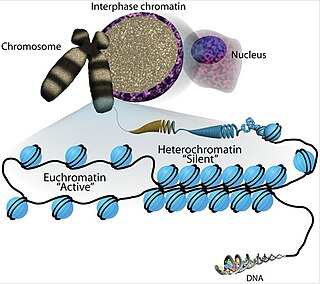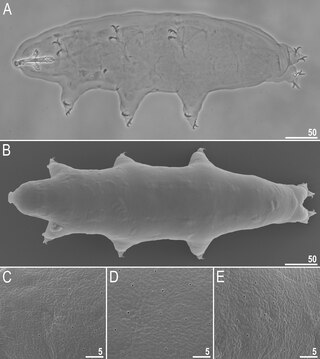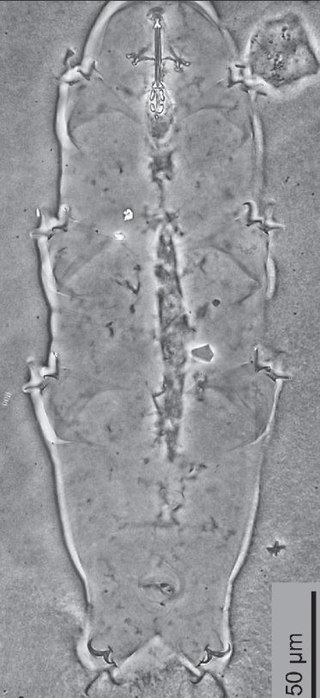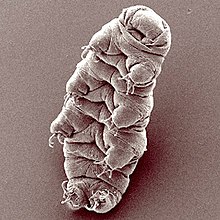
Euchromatin is a lightly packed form of chromatin that is enriched in genes, and is often under active transcription. Euchromatin stands in contrast to heterochromatin, which is tightly packed and less accessible for transcription. 92% of the human genome is euchromatic.

Eutardigrada are a class of tardigrades (Tardigrada) without lateral appendages. Primarily freshwater bound, some species have secondarily gained the ability to live in marine environments (Halobiotus). By cryptobiosis many species are able to live temporarily in very dry environments. More than 700 species have been described.

Panarthropoda is a proposed animal clade containing the extant phyla Arthropoda, Tardigrada and Onychophora. Panarthropods also include extinct marine legged worms known as lobopodians ("Lobopodia"), a paraphyletic group where the last common ancestor and basal members (stem-group) of each extant panarthropod phylum are thought to have risen. However the term "Lobopodia" is sometimes expanded to include tardigrades and onychophorans as well.

S phase (Synthesis phase) is the phase of the cell cycle in which DNA is replicated, occurring between G1 phase and G2 phase. Since accurate duplication of the genome is critical to successful cell division, the processes that occur during S-phase are tightly regulated and widely conserved.
Histone H2B is one of the 5 main histone proteins involved in the structure of chromatin in eukaryotic cells. Featuring a main globular domain and long N-terminal and C-terminal tails, H2B is involved with the structure of the nucleosomes.

Transcriptional adapter 3-like is a protein that in humans is encoded by the TADA3 gene. Cytogenetic location: 3p25.3

The Chromodomain-Helicase DNA-binding 1 is a protein that, in humans, is encoded by the CHD1 gene. CHD1 is a chromatin remodeling protein that is widely conserved across many eukaryotic organisms, from yeast to humans. CHD1 is named for three of its protein domains: two tandem chromodomains, its ATPase catalytic domain, and its DNA-binding domain.

Tardigrades, known colloquially as water bears or moss piglets, are a phylum of eight-legged segmented micro-animals. They were first described by the German zoologist Johann August Ephraim Goeze in 1773, who called them Kleiner Wasserbär. In 1777, the Italian biologist Lazzaro Spallanzani named them Tardigrada, which means "slow steppers".

Echiniscus testudo is a cosmopolitan species of tardigrade.

Hypsibius is a genus of tardigrades in the class Eutardigrada.

Ramazzottius is a genus of water bear or moss piglet, a tardigrade in the class Eutardigrada.
Eremobiotus is a genus of tardigrade in the class Eutardigrada.

Acutuncus is a genus of tardigrades containing a single species, Acutuncus antarcticus. Tardigrades, which are eight-legged micro-animals, are commonly referred to as water bears or moss piglets and are found all over the world in varying extreme habitats. First discovered in 1904 and originally named Hypsibius antarcticus, Acutuncus antarcticus is the most abundant tardigrade species in Antarctica.

Milnesium tardigradum is a cosmopolitan species of tardigrade that can be found in a diverse range of environments. It has also been found in the sea around Antarctica. M. tardigradum was described by Louis Michel François Doyère in 1840. It contains unidentified osmolytes that could potentially provide important information in the process of cryptobiosis.

Milnesium is a genus of tardigrades. It is rather common, being found in a wide variety of habitats across the world. It has a fossil record extending back to the Cretaceous, the oldest species found so far is known from Turonian stage deposits on the east coast of the United States. Milnesiums are one of the most desiccation and radiation-resistant invertebrates on Earth because of their unique ability to transform into a "tun" state and utilize intrinsically disordered proteins when experiencing extreme environments.
Dsup is a DNA-associating protein, unique to the tardigrade, that suppresses the occurrence of DNA breaks by radiation. When human HEK293 cells were engineered with Dsup proteins, they showed approximately 40% more tolerance against X-ray radiation.

Macrobiotus shonaicus is a species of tardigrade in the family Macrobiotidae. As of 2018 it is only known from its type locality: Tsuruoka, Japan. The species description was published in 2018. The insides of their first three pairs of legs have a slight fold above their claws, and their eggs have processes whose terminal discs split off into thin filaments.

Hypsibius vaskelae is a species of tardigrade in the class Eutardigrada. The species was described from a freshwater sample near Saint Petersburg, Russia. It has wrinkled cuticle and cuticular bars between the bases of its claws on the first four legs. The species most closely resembles Hypsibius marcelli and Hypsibius septulatus, although has a wrinkled dorsal cuticle, thinner claws, and presence of lunules on the claws of all legs.
H3K36me3 is an epigenetic modification to the DNA packaging protein Histone H3. It is a mark that indicates the tri-methylation at the 36th lysine residue of the histone H3 protein and often associated with gene bodies.
Bertolanius is a genus of tardigrades belonging to the family Eohypsibiidae.














